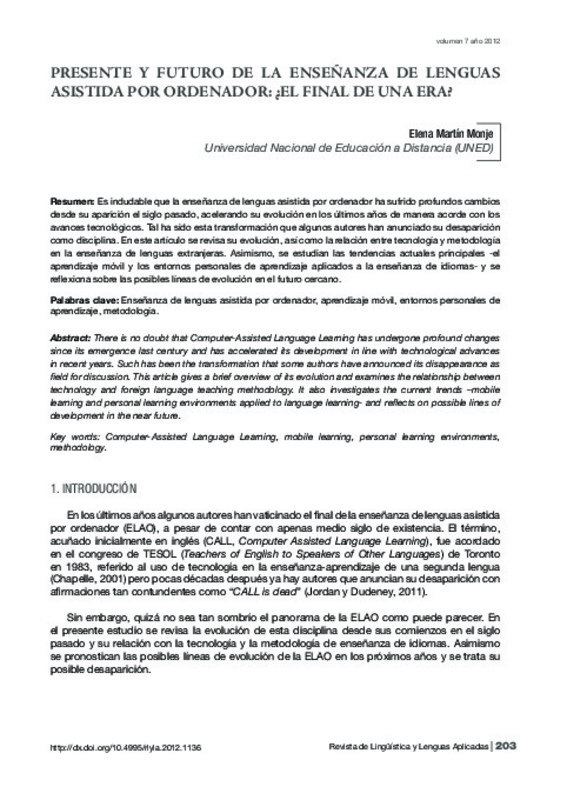Attwell, G. (2007). "Personal Learning Environments - the future of eLearning?" eLearning papers 2, en http://www.elearningeuropa.info/files/media/media 11561.pdf [fecha acceso 10.12.2012].
Barrett, B. y Sharma, P. (2007). Blended Learning. Oxford: Macmillan.
Bax, S. (2003). "CALL - past, present and future", System 31: 13-28. http://dx.doi.org/10.1016/S0346-251X(02)00071-4
[+]
Attwell, G. (2007). "Personal Learning Environments - the future of eLearning?" eLearning papers 2, en http://www.elearningeuropa.info/files/media/media 11561.pdf [fecha acceso 10.12.2012].
Barrett, B. y Sharma, P. (2007). Blended Learning. Oxford: Macmillan.
Bax, S. (2003). "CALL - past, present and future", System 31: 13-28. http://dx.doi.org/10.1016/S0346-251X(02)00071-4
British Educational Communications and Technology Agency (BECTA). (2004). What the research says about Virtual Learning Environments in teaching and learning, en https://www.education.gov.uk/publications/standard/publication Detail/Page1/15003 [fecha acceso 13.12.2011].
Casado, R. (Coord.). (2006). Claves de la alfabetización digital. Madrid: Ariel y Fundación Telefónica.
Chambers, A. y Bax, S. (2006). "Making CALL work: Towards normalization", System 34: 465-479. http://dx.doi.org/10.1016/j.system.2006.08.001
Chapelle, C. (2001). Computer applications in second language acquisition. Cambridge: Cambridge University Press. http://dx.doi.org/10.1017/CBO9781139524681
Chapelle, C. (2007). Towards Adaptive CALL, en http://www.public.iastate.edu/~apling/TSLL/5th_2007/proceedings2007/contents.html [fecha acceso: 2.12.2011].
Chapelle, C. y Hegelheimer, V. (2004). "Language teacher in the 21st century" en S. Fotos, y C. Browne (eds.) New perspectives on CALL for second language classrooms. Mahwah, NJ: Lawrence Erlbaum, 297-316.
Claypole, M. (2010). Controversies in ELT. Norderstedt: LinguaBooks.
Colpaert, J. (2006). "Pedagogy-driven design for online language teaching and learning", CALICO Journal, 23(3): 477-497.
Council of Europe (2001). Common European Framework of Reference for Languages. Cambridge: Cambridge University Press.
Davies, G. (2007). Where are we now and where are we going? en http://www.camsoftpartners.co.uk/docs/UCALL_Keynote.htm [fecha acceso: 1.12.2011].
Davies, G. (Ed.). (2006). Information and communication technologies for language teachers, en http://www.ict4lt.org [fecha acceso: 2.12.2011].
Dudeney, G. y Hockly, N. (2011). "Digital literacies and the language classroom", en S. House (coord.) Didáctica del inglés. Classroom Practice. Barcelona: Graó, 51-76.
Felix, U. (2003). "Pedagogy on the line: Identifying and closing the missing links" en U. Felix (ed.) Language learning online: Towards best practice. Lisse: Swets & Zeitlinger, 147-170.
Fotos, S. y Browne, C. (Eds.). (2004). New perspectives on CALL for second language classrooms. Mahwah, NJ: Lawrence Erlbaum.
Garrett, N. (2009). "Computer-Assisted Language Learning trends and issues revisited: Integrating innovation", The Modern Language Journal, 93: 719-740. http://dx.doi.org/10.1111/j.1540-4781.2009.00969.x
Gutiérrez Martín, A. (2003). Alfabetización digital. Algo más que ratones y teclas. Madrid: Gedisa.
Guth, S. (2009). "Personal learning environments for language learning" en M. Thomas (ed.) Handbook of research on Web 2.0 and second language learning. Hershey: IGI-Global, 451-471. http://dx.doi.org/10.4018/978-1-60566-190-2.ch024
Hanson-Smith, E. (2001). "Computer-assisted language learning" en R. Carter y D. Nunan (eds.) The Cambridge guide to teaching English to speakers of other languages. Cambridge: Cambridge University Press, 107-119. http://dx.doi.org/10.1017/CBO9780511667206.016
Hanson-Smith, E. (2003). "A brief history of CALL theory", CATESOL Journal, 15 (1): 21-30.
Hubbard, P. y Levy, M. (Eds.). (2006). Teacher Education in CALL. Filadelfia: John Benjamins.
Jordan, G. y Dudeney, G. (2011, Marzo). "Whatever happened to CALL". TESOL-Spain Annual Convention. Madrid.
Kukulska-Hulme, A. (2009). "Will mobile learning change language learning?", ReCALL, 21(2): 157-165. http://dx.doi.org/10.1017/S0958344009000202
Kukulska-Hulme, A. y Shield, L. (2008). "An overview of mobile assisted language learning: From content delivery to supported collaboration and interaction", ReCALL, 20(3): 271-289. http://dx.doi.org/10.1017/S0958344008000335
Levy, M. (1997). Computer-assisted language learning: Context and conceptualization. Oxford: Oxford University Press.
Levy, M. y Stockwell, G. (2006). CALL dimensions: Options and issues in computer-assisted language learning. Mahwah, NJ: Lawrence Erlbaum.
Littlemore, J. (2002). "Setting up a course in ICT for Language Teachers: some essential considerations", CALL-EJ Online 4, 1, en http://callej.org/journal/4-1/littlemore.html [fecha acceso: 5.12.2011].
Neumeier, P. (2005). "A closer look at blended learning - parameters for designing a blended learning environment for language teaching and learning", ReCALL, 17(2): 163-178. http://dx.doi.org/10.1017/S0958344005000224
Organización para la Cooperación y Desarrollo Económicos (OCDE) (2011), Resultados del Informe PISA 2009: Estudiantes en Internet. Tecnologías y rendimiento digitales. Madrid: Ministerio de Educación, Editorial Santillana.
Pedró, F. (2011). Tecnología y escuela: lo que funciona y por qué. Madrid. Fundación Santillana.
Pérez Crespo, S. (2007). ¿Cómo será la Web 3.0? en http://sociedadinformacion.fundacion.telefonica.com/DYC/SHI/seccion=1188&idioma=es_ES&id=2009100116310011&activo=4.do?elem=4215 [fecha acceso 30.11.2011].
Prensky, M. (2001). "Digital Natives, Digital Immigrants", On the Horizon, Vol. 9 (5), en http://www.marcprensky.com/writing/Prensky%20-20Digital%20Natives,%20Digital%20Immigrants%20-%20Part1.pdf [fecha acceso 12.12.2011].
Reinders, H. y White, C. (2011). Special Issue of Language Learning & Technology on Learner Autonomy and New Learning Environments en http://llt.msu.edu/issues/october2011/v15n3.pdf [fecha acceso 12.12.2011].
Russel, S. (2011). 50 iPhone apps to help you learn a new language en http://www.onlinecollegedegrees.org/2009/04/07/50-iphone-apps-to-help-you-learn-a-new-language [fecha acceso 13.12.2011].
Shield, L. y Kukulska-Hulme, A. (2008). Special issue of ReCALL on Mobile Assisted Language Learning. Cambridge: Cambridge University Press.
Skinner, B. F. (1957). Verbal Behavior. Englewood Cliffs: Prentice-Hall. http://dx.doi.org/10.1037/11256-000
Stockwell, G. (2007). "A review of technology choice for teaching language skills in the CALL literature", ReCALL 19 (2): 105-120. http://dx.doi.org/10.1017/S0958344007000225
Varela, R. (Coord.). (2003). All about teaching English. Madrid: CERASA.
Warschauer, M. (2004). "Technological change and the future of CALL" en S. Fotos y C. Brown (eds.) New Perspectives on CALL for Second and Foreign Language Classrooms. Mahwah, NJ: Lawrence Erlbaum Associates, 15-25.
Warschauer, M. y Healey, D. (1998). "Computers and language learning: An overview", Language Teaching 31: 57-71. http://dx.doi.org/10.1017/S0261444800012970
Zeldman, J. (2006). Web 3.0 en http://www.alistapart.com/articles/web3point0/ [fecha acceso 31.11.2011].
[-]








